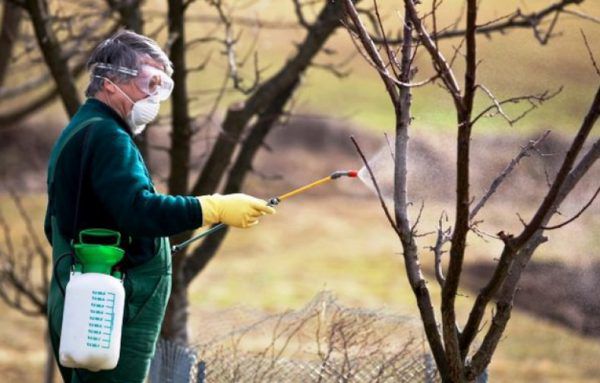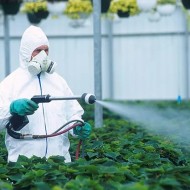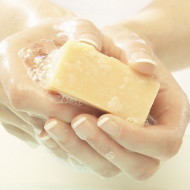Fungicide "DNOK": instructions for use, advice to gardeners on processing
Content
Detailed description of the drug
DNOC is an insecticide, fungicide and herbicide in one bottle. A potent product used for extremely rare (every three years) industrial processing and is not recommended for small areas. However, gardeners still use it for their own purposes, carefully measuring the dosage before processing the garden.

The fungicide is suitable for treating:
- fruit trees (apricot, quince, cherry, pear, peach, sweet cherry, apple tree);
- berry bushes (gooseberries, currants);
- vineyards.
A powerful drug that doubles as a pest. As an insecticide, "DNOC" destroys ticks, scale insects, aphids, moths, tartar, leafworm and other parasitic insects. As a fungicide, it is effective against powdery mildew, scab, rust, all types of rot, curl, powdery mildew.
The product is available in yellow powder form with a pungent odor. The manufacturer provides two types of packaging: cardboard bobbin containers (20 kg) and sealed cellophane packaging (2 g).
Video "Preparation" DNOC "for plant protection"
This video tells about the features of the use of an insecticidal agent.
Chemical composition
DNOK has two main active ingredients: ammonium salt (60%) and dinitroorthocresol (40%). In addition to them, the preparation contains various additional components and catalysts. Ammonium sulfate acts as a filler. Granular powder is poorly soluble in water, so organic solvents are often used to dilute the fungicide.
Active ingredient and mechanism of action
The main active component of DNOC is 4,6-dinitro-o-cresol, a substance derived from nitrophene. Its principle of action is to stop the initial stage of the disease and the rapid destruction of insect pests. Once in plant cells, the drug reaches its maximum concentration in 2 days, and the effect of its use is noticeable already on the third day, remaining for 1 month after treatment.
At low temperatures and high humidity, the fungicide can penetrate the soil to a depth of 7 cm, while acting as a pesticide. Warming and drying of the soil contribute to the movement of the drug into the upper layers.
Terms of application
The effectiveness of the drug "DNOK" depends on the timely processing of fruit and berry crops. Experienced gardeners note only two periods suitable for spraying with fungicide.
Spring processing
Often, plants are treated with a fungicide in early spring, while the buds have not yet blossomed. Wait until the end of the frost and the temperature not lower than +4 ° С. It is important to carry out processing before the start of the movement of juices, then the action of the drug will be more effective.In addition, during this period it is easier to destroy insects that have not yet left wintering. Before spraying, a covering material should be placed on the ground so that the poisonous substance does not get into the ground.

Processing in autumn
In the fall, the procedure is carried out less often and only after the plant has dropped the leaf. The procedure differs from the spring one in several nuances:
- they do not cover the ground, since the product must penetrate into the ground, where it will work as a pesticide;
- the solution must be made weakly concentrated;
- autumn processing is harmless to the soil, since it does not affect its fertility in the next season;
- spraying plants before wintering will not negatively affect them in the spring.
Standards for fruit and berry crops
Since the drug is hardly soluble in water, gardeners recommend preparing a solution for treatment as follows: mix 50 g of "DNOK" with 1 liter of organic solvent and dilute the resulting concentrate with 10 liters of water, stirring thoroughly. Spraying is carried out using a spray bottle. The consumption rates of the fungicide for various crops are:
- 8 kg per 1 ha - for shrubs;
- 10 kg per 1 ha - for fruit trees.

Apple tree, pear, quince
These fruit crops require the highest drug concentration - 15 liters per 0.1 ha. Before spraying, cover the soil with tarpaulin or polyethylene so that the solution does not get into the soil. Particular attention should be paid to the procedure if it takes place in the immediate vicinity of vegetable or flower crops.
Timely processing will prevent scab, rot and maniliasis from developing on trees. Also, the insectofungicide will destroy aphids, leafworms, scale insects, ticks, honey beetles, moths, beetles and moths.
Peach, apricot, cherry, plum
The solution for processing should be made less saturated than for apple, pear, quince. Enough 10 liters of "DNOK" per 0.1 hectare to destroy ticks, scale insects, leaf rollers, honey beetles, aphids and moths. The drug effectively fights curliness, moniliosis, clotterosporia. Its use also prevents further development of diseases.
Gooseberry, currant
Along with apple, pear and quince, berry bushes also require an increased dose of fungicide (15 liters per 0.1 ha). Processing gooseberries, red and black currants will save the plant from aphids, ticks, leaf rollers, moths, scale insects. The drug will prevent the development of rust, leaf spots, powdery mildew, anthracnose and septoria.
Grape
The use of "DNOK" in viticulture provides for a number of features. Before the procedure, the plant must be thinned out by cutting off unnecessary shoots. This helps to stop the multiplication of pathogenic microorganisms and insect larvae. It is necessary to treat grapes with a fungicide in early spring, before the juices begin to move, at the rate of 8 liters of the drug per 0.1 hectare. Thus, the culture will be protected from oidium, spotting, cercospora, anthracnose and necrosis for the whole season. Ticks, aphids, worms will also not tolerate treatment.

Toxicity and Precautions
Insectofungicide "DNOC" refers to drugs of high toxicity class. With dry powder, as well as with a solution, it is necessary to work very carefully, observing safety precautions. Dinitroorthocresol in combination with organic solvents is an explosive mixture. From the instructions on the package, it follows that the product is not intended for private garden plots, but many gardeners ignore this prohibition.
Precautions when working with DNOC include the following actions:
- Spraying must be carried out in special protective equipment (protective suit, respirator, rubber boots, gloves, goggles). It is best to use a gas mask when handling a dangerous fungicide.
- Keep other people or pets away from the cultivated area. It is better to warn the neighbors on the site in advance about the planned procedure.
- At the end of the treatment, do not touch dirty clothes with your hands. The chemical is highly irritating to exposed skin and mucous membranes.
- The spray bottle should be washed thoroughly and then you should shower yourself.
DNOC is very dangerous for humans. Once inside the body through the respiratory tract, it can disrupt metabolism and lead to serious illness.
The concentration of 70–80 mcg of the poisonous substance per 1 ml of blood is lethal.
In case of accidental ingestion of the drug, do not consume hot drinks, alcohol, fats, and also make compresses.
Storage term and conditions
Insectofungicide "DNOC" is valid for 3 years from the production date indicated on the package. The drug should be stored away from food, dishes and medicines. The place should be dark, dry, out of reach of children and pets. It is strictly prohibited to keep the chemical near fuels and lubricants or in a room with gasoline vapors.
Do not dispose of the chemical with household waste. It also cannot be burnt or buried. It is processed only by a special service for the disposal of highly toxic waste.
Reviews about DNOK are quite contradictory. However, experienced gardeners consider it one of the most effective remedies and use it in their garden plots, despite all the warnings. Insectofungicide is not a prohibited drug, but it must be used with extreme caution.



